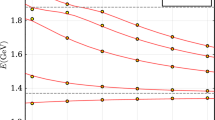Abstract
In this talk I review our recent studies on meson-baryon systems with strangeness \(-\,1\) and \(-\,2\). The motivation of our works is to find resonances generated as a consequence of coupled channel meson-baryon interactions. The coupled channels are all meson-baryon systems formed by combining a pseudoscalar or a vector meson with an octet baryon such that the system has the strange quantum number equal to \(-\,1\) or \(-\,2\). The lowest order meson-baryon interaction amplitudes are obtained from Lagrangians based on the chiral and the hidden local symmetries related to the vector mesons working as the gauge bosons. These lowest order amplitudes are used as an input to solve the Bethe–Salpeter equation and a search for poles is made in the resulting amplitudes, in the complex plane. In case of systems with strangeness \(-\,1\), we find evidence for the existence of some hyperons such as: \(\varLambda (2000)\), \(\varSigma (1750)\), \(\varSigma (1940)\), \(\varSigma (2000)\). More recently, in the study of strangeness \(-\,2\) systems we have found two narrow resonances which can be related to \(\varXi (1690)\) and \(\varXi (2120)\). In this latter work, we have obtained the lowest order amplitudes relativistically as well as in the nonrelativistic approximation to solve the scattering equations. We find that the existence of the poles in the complex plane does not get affected by the computation of the scattering equation with the lowest order amplitudes obtained in the nonrelativistic approximation.
Similar content being viewed by others
References
A. Ramos, E. Oset, C. Bennhold, D. Jido, J.A. Oller, U.G. Meissner, Dynamical generation of hyperon resonances. Nucl. Phys. A 754, 202 (2005)
M.F.M. Lutz, J. Hofmann, Dynamically generated hidden-charm baryon resonances. Int. J. Mod. Phys. A 21, 5496 (2006)
S. Sarkar, B.X. Sun, E. Oset, M.J. Vicente Vacas, Dynamically generated resonances from the vector octet-baryon decuplet interaction. Eur. Phys. J. A 44, 431 (2010)
E. Oset et al., Dynamically generated resonances. Prog. Theor. Phys. Suppl. 186, 124 (2010)
B.-X. Sun, Y.-W. Wang, Vector meson-baryon octet interaction and resonances generated dynamically. Int. J. Mod. Phys. Conf. Ser. 29, 1460211 (2014)
E. Oset, A. Ramos, Dynamically generated resonances from the vector octet-baryon octet interaction. Eur. Phys. J. A 44, 445 (2010)
T. Hyodo, D. Jido, A. Hosaka, Compositeness of dynamically generated states in a chiral unitary approach. Phys. Rev. C 85, 015201 (2012)
K.P. Khemchandani, A. Martinez Torres, E. Oset, The N*(1710) as a resonance in the pi pi N system. Eur. Phys. J. A 37, 233–243 (2008)
A. Martinez Torres, K.P. Khemchandani, E. Oset, Three body resonances in two meson-one baryon systems. Phys. Rev. C 77, 042203 (2008)
A. Martinez Torres, K.P. Khemchandani, E. Oset, Solution to Faddeev equations with two-body experimental amplitudes as input and application to \(\text{ J }^{**}\text{ P } = 1/2+\), \(\text{ S } = 0\) baryon resonances. Phys. Rev. C 79, 065207 (2009)
G. Ecker, Chiral perturbation theory. Prog. Part. Nucl. Phys. 35, 1 (1995)
A. Pich, Chiral perturbation theory. Rep. Prog. Phys. 58, 563 (1995)
E. Oset, A. Ramos, Non perturbative chiral approach to s-wave anti-K N interactions. Nucl. Phys. A 635, 99–120 (1998)
M. Bando, T. Kugo, K. Yamawaki, Nonlinear Realization and Hidden Local Symmetries. Phys. Rept. 164, 217 (1988)
M. Bando, T. Kugo, K. Yamawaki, On the vector mesons as dynamical gauge bosons of hidden local symmetries. Nucl. Phys. B 259, 493 (1985)
K.P. Khemchandani, H. Kaneko, H. Nagahiro, A. Hosaka, Vector meson-Baryon dynamics and generation of resonances. Phys. Rev. D 83, 114041 (2011)
K.P. Khemchandani, A. Martinez Torres, H. Kaneko, H. Nagahiro, A. Hosaka, Coupling vector and pseudoscalar mesons to study baryon resonances. Phys. Rev. D 84, 094018 (2011)
C. Patrignani et al., Particle data group. Chin. Phys. C 40, 100001 (2016)
L. Guo et al., Cascade production in the reactions gamma p –> K+ K+ (X) and gamma p –> K+ K+ pi- (X). Phys. Rev. C 76, 025208 (2007)
R. Schumacher, CLAS Collaboration, Strangeness physics with CLAS at Jefferson lab. AIP Conf. Proc. 1257, 100 (2010)
T. Nagae, The J-PARC project. Nucl. Phys. A 805, 486 (2008)
M.F.M. Lutz et al. [PANDA Collaboration], Physics performance report for PANDA: strong interaction studies with antiprotons. arXiv:0903.3905 [hep-ex]
K. Abe et al., [Belle Collaboration], Observation of Cabibbo suppressed and W exchange Lambda+(c) baryon decays. Phys. Lett. B 524, 33 (2002)
B. Aubert et al., [BaBar Collaboration], Measurement of the spin of the Xi(1530) resonance, Phys. Rev. D 78, 034008 (2008)
B. Aubert et al., [BaBar Collaboration], Measurement of the mass and width and study of the spin of the \(\varXi (1690)\) 0 resonance from \(\varLambda ^+_{c} \rightarrow \varLambda \bar{K}^0 K^{+}\) decay at Babar, hep-ex/0607043
J.A. Oller, E. Oset, Chiral symmetry amplitudes in the S wave isoscalar and isovector channels and the sigma, f0(980), a0(980) scalar mesons,” Nucl. Phys. A 620, 438 (1997) [Erratum-ibid. A 652, 407 (1999)]
E.E. Jenkins, M.E. Luke, A.V. Manohar, M.J. Savage, Chiral perturbation theory analysis of the baryon magnetic moments. Phys. Lett. B 302, 482–490 (1993)
U.-G. Meissner, S. Steininger, Baryon magnetic moments in chiral perturbation theory. Nucl. Phys. B 499, 349–367 (1997)
D. Jido, A. Hosaka, J.C. Nacher, E. Oset, A. Ramos, Magnetic moments of the Lambda(1405) and Lambda(1670) resonances. Phys. Rev. C 66, 025203 (2002)
K.P. Khemchandani, A. Martinez Torres, H. Nagahiro, A. Hosaka, Phys. Rev. D 85, 114020 (2012)
K.P. Khemchandani, A. Martinez Torres, A. Hosaka, H. Nagahiro, F.S. Navarra, M. Nielsen, Why \(\varXi (1690)\) and \(\varXi (2120)\) are so narrow? Phys. Rev. D 97, 034005 (2018)
Author information
Authors and Affiliations
Corresponding author
Rights and permissions
About this article
Cite this article
Khemchandani, K.P., Martínez Torres, A., Hosaka, A. et al. Multistrange Meson-Baryon Dynamics and Resonance Generation. Few-Body Syst 59, 29 (2018). https://doi.org/10.1007/s00601-018-1338-2
Received:
Accepted:
Published:
DOI: https://doi.org/10.1007/s00601-018-1338-2




